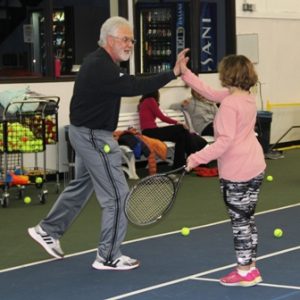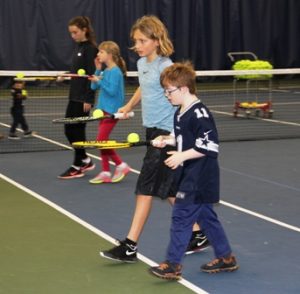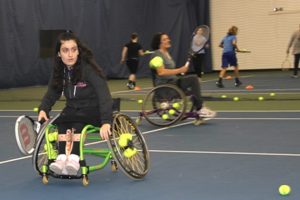STRIDE Tennis Serves Up Something for Everybody
posted on: February 18, 2020 |

“Great shot, Samantha.”
“How we doing, Dash? Show me some backhands here.”
“Get those hands a little closer together, Andrew.”
Those are the words of instructor Dave Graham as he zig zags across the court shouting words of encouragement to the participants in the STRIDE Tennis program.
Each Sunday for the past 11 years Dave has made the trip from his home in Burnt Hills to SPORTIME in Schenectady to at first assist, and now lead the 20-week tennis program (he also directs the six-week outdoor tennis program that is held in the spring/summer).
The first half-hour of the program is dedicated to skill development where participants perform tennis related drills or play games designed to teach coordination and agility. Once they are warmed up, each player takes turns hitting balls over the net.

“We try to emphasize the basics such as forehands, backhands, and volleys,” says Dave. “The ultimate goal is get each athlete to the point where they can get on the court and rally a bit with a parent or friend. But the number one priority each week is to have fun.”
Judging from the smiles on the court and the feedback from parents, the program is accomplishing that and more. Jen, whose 15-year old son Andrew is in the program, says he is enjoying his first year playing tennis.
“Andrew is minimally verbal, and if there wasn’t a program like this, he would need one-on-one coaching,” says Jen. “Besides being extremely expensive, that method of learning means there is limited social interaction. Here there’s a nice mix of kids, and of course, the volunteers are great.”
One of those volunteers is Rory, who assisted the program for a number of years, and still helps out when she’s home from college. As someone who has an autistic brother, Rory understands the struggles faced by those with disabilities and the positive impact sports can have in their lives. “They all go through rough patches,” she says. “But it’s great to see how activities like tennis can help them get through to the other side.”

The tennis program also includes two participants who play using specially equipped wheelchairs that help them make the movements needed to maneuver around the court. One of those individuals is Maddie, a 15-year old with spina bifida who has been in the program for the past two years. Over that time, she has seen a dramatic improvement in her tennis skills which has opened her eyes to even bigger possibilities.
“Now that I can actually play, I’m thinking about trying out for the JV tennis team,” she says.
Helping her achieve that goal will be people like Jim Neal, a longtime tennis instructor and volunteer who works closely with the wheelchair athletes.
Jim is so passionate about helping wheelchair players succeed on the court that he has attended instructional conferences on the subject and even purchased his own wheelchair so he could “see the game from the players’ level.”
He sums up his teaching approach like this: “If you are faced with a challenge and want to play tennis, I’ll try to figure out a way for you to do it.”
It’s a philosophy that not only works well for tennis, but could really be the theme for any of the STRIDE programs.
Because if there is one thing synonymous with STRIDE, it’s the idea that when you take someone with a desire to achieve and surround them with the right people and resources, anything is possible.